Introduction
Identifying Fossils of the Salem Formation
Reconstructing the Ancient Environment
About the Salem Formation
Identifying Different Types of Salem Limestone
Why Salem Limestone Pervades the City
Finding Salem Limestone at Home and in the Neighborhood
Acknowledgments and Sources
Introduction
If you visit the Reflecting Pool at the foot of Capitol Hill, be sure to examine the stone bordering the Pool:

Or, walk one block north and one block west from the Reflecting Pool, and inspect the retaining wall of the Department of Labor Building on the east side of Third St., N.W. between Constitution Ave. and C St., N.W.:

Or, when visiting the National Museum of Women in the Arts, 1250 New York Ave., N.W., stop by the narrow western face of the building on Thirteenth St., N.W., where the surface looks slightly rough:

Or, when you attend a performance at the Lisner Auditorium of George Washington University, at the southwest corner of 21st St. and H St., N.W., note the surface of the capstone to the side of steps leading to the entrance, closest to H St.:

Now, at any of these locations, take a close look at the stone surface. Try, for example, the wall of the National Museum of Women in the Arts, west (13th St.):

No, no. That is not close enough. Take a really close look, a couple of inches from the surface.

From that distance, the solid stone is revealed to be a dense mass of tiny skeletal structures, compressed together. Depending on the location, you can see what appear to be netting (sometimes termed, “rice chex” by geologists), tiny shell fragments, tiny lifesaver-like circles, and more:
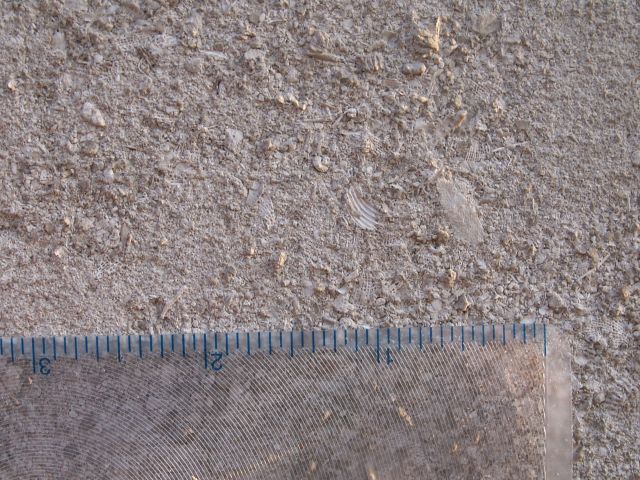
The shapes are fossils from a coastal ecosystem in a shallow inland sea, approximately 350 million years ago, in what is now the state of Indiana. Known to geologists as the Salem Formation, and more popularly called “Indiana Limestone,” this stone has become the most widely used limestone on buildings in the United States. It is found abundantly throughout D.C., where it can be seen in museums and monuments, in bridges and in banks, in schools and in churches, in massive office buildings and in low-slung commercial strips, in huge apartment buildings and in modest private homes. It can be seen in hundreds of buildings and in every quadrant of the city, from upper Northwest to far Southeast.
Woven throughout the fabric of the city, the Salem Limestone surrounds the resident and the visitor with countless traces of life in the Paleozoic.
It is worth a look.
A close one.
Identifying Fossils of the Salem Formation
Fossils of the Salem Formation: an overview
Fossils of more than 187 different species have been identified in the Salem Formation. Most of the fossil grains forming the limestone are echinoderm and bryozoan debris — the broken and fragmented remains of their calcareous skeletons. These are not easily recognizable by the unaided eye, but larger fossil fragments (“macrofossils”) have been identified by geologists, including:
Corals 16 species
Echinoderms (mostly crinoids) 34 species
Sponges 1 species
Annelids (segmented worms) 4 species
Bryozoans 38 species
Brachiopods 29 species
Pelecypods (bivalves like modern clams or scallops) 14 species
Gastropods (relatives of modern snails) 41 species
Cephalopods (nautiloids and ammonoids) 5 species
Trilobites 1 species
Also, various ostracodes and fish species.
This is a formidable list, and a daunting one to the layman. Distinguishing different types of fossils can be difficult for non-specialists under the best conditions. In the “fossil hash” of the Salem Formation, identification is further impeded by two factors:
1. “Stunted” animals. In a comprehensive 1905 study, the Indiana Geological Survey observed that the fauna appeared “stunted” – an observation that the casual observer will heartily second. Nearly all of the recognizable fossils are small, and many are extremely small. (For example, compare the crinoids here to the large crinoids shown in Gallery 9).
2. Abrasion and sorting prior to deposition. Few fossils in this limestone were deposited and buried where they lived. Instead, in the high energy shoal environment of the shallow sea, the fossils were moved by currents, often broken up and abraded prior to being buried under later sediments. Crinoid stalks are never intact, shells typically appear in various fragments, and smaller pieces are often coated further in calcium.
The careful observer can still identify the major types of fossils, even if the species is likely to be elusive. In addition, trace fossils – the tracks and disturbances left in the sediment by organisms – can be identified easily and without eyestrain. Four major types of fossils are discussed in detail below, as well as trace fossils.
Commonly visible fossil types
Bryozoans
(Greek, “moss animals” because of their plantlike appearance) are a phylum of tiny animals living in colonial structures that often superficially resemble corals. Originating in the Ordovician, thousands of bryozoan species exist today, but they were also plentiful in the shallow marine environments of the Mississippian period. Typically, they are found in branching, calcareous structures that form upright, often stem-like growths, termed “zoaria.” The zoaria are generally small – rarely exceeding two feet in diameter – and have been described by geologists as having a “delicate, lacy appearance.”

Source: Maryland Geological Survey, E.S. No. 4, Collecting Fossils in Maryland, p. 19.
Bryozoans live in minute openings (“zooecia”) that cover the entire surface of the zoaria. Although the bryozoan zoaria and the tiny organisms living within them suggest a similarity to coral, bryozoans are quite different from corals. Their bodies are sac-like, and have tentacles covered with cilia to collect food at the opening of the zooecium. They have a digestive tube with muscles controlled by a nerve ganglion, but no head or brain. They are capable of retracting the body in alarm or extending it to feed.
The bryozoan zoaria visible in the Salem Limestone are fragments that have been broken up and transported after death. Yet, they remain clearly visible in many surfaces. Look for structures that resemble netting, which are typically fenestrate bryozoans:
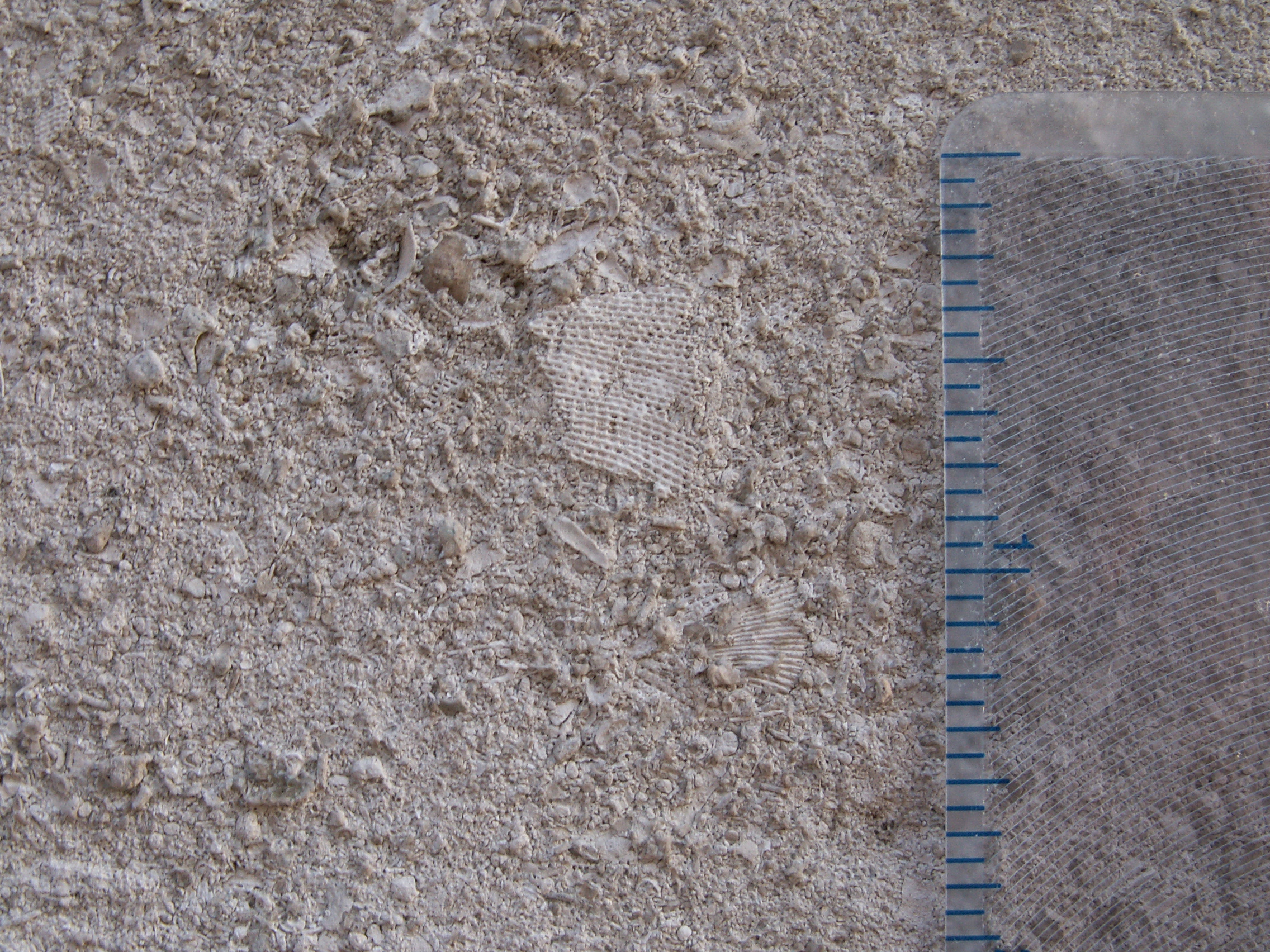
Other bryozoans have a twig-like or branching appearance:
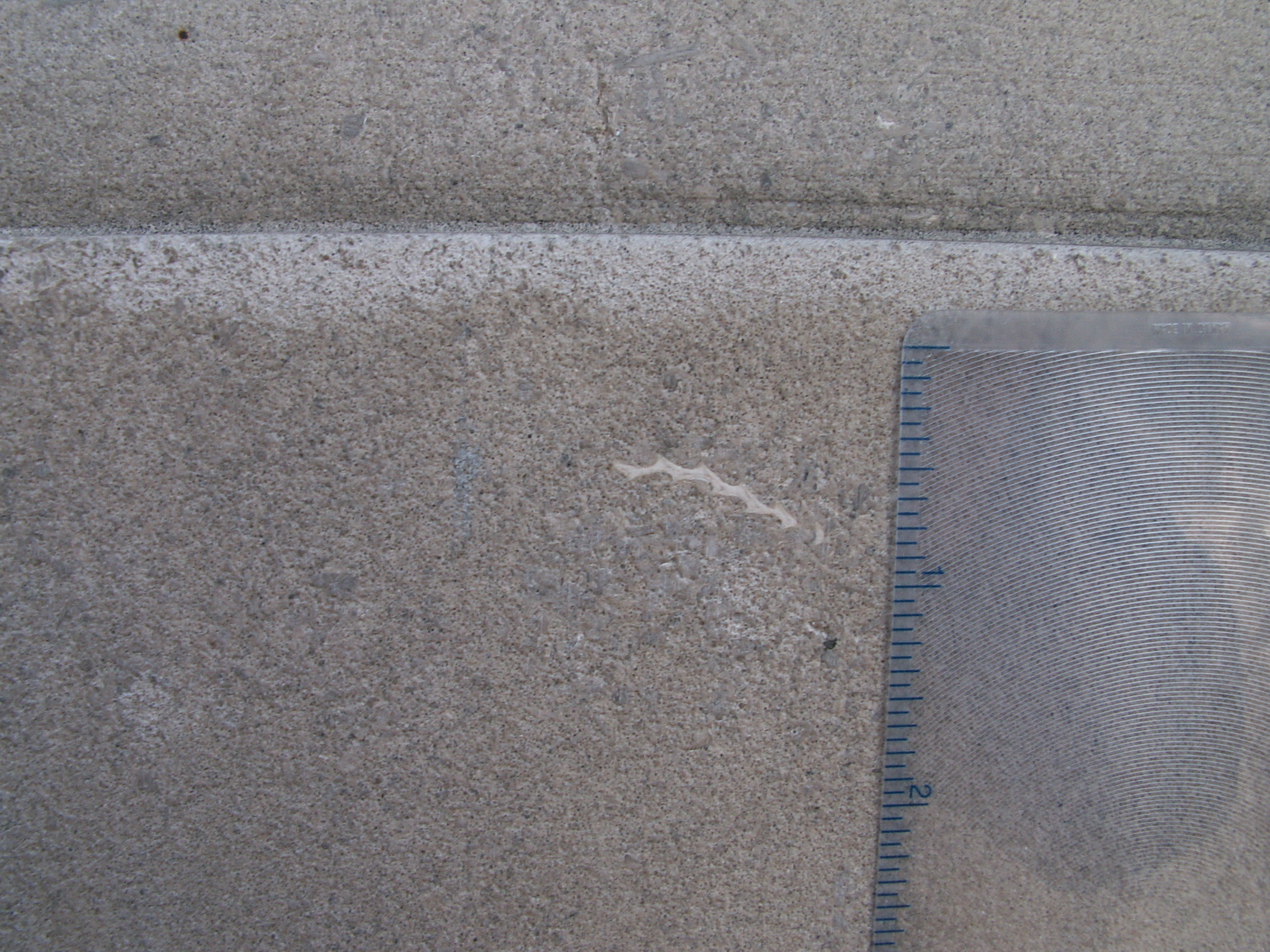
In the photograph below, the bryozoans are the broken, but tubular branching shapes between ¼” and 5/8” to the left of the ruler.
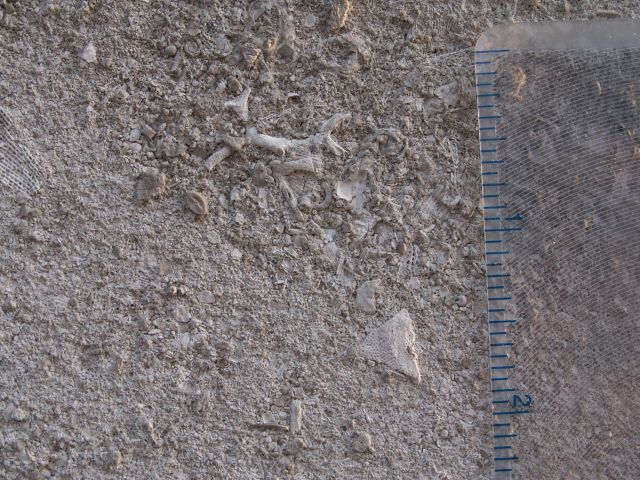
Crinoids. Crinoids, often informally called “sea lilies,” are stalked echinoderms, of the same phylum as modern starfish, sand dollars and sea urchins. They appeared in the Early Ordovician. Although their numbers dropped after the close of the Paleozoic, crinoid species exist today. The structure and functions of crinoids are discussed in detail in Gallery 9. In brief, although they took many forms, crinoids commonly grew as stalks anchored to the sea floor, supporting a vaguely flower-like head or “calyx” which housed the main body organs. The animal lived as a filter-feeder. A picture of a modern crinoid, similar to many in the Mississippian, appears below.

Source: Maryland Geological Survey E.S. No. 4, p. 38, Fig. 35.
After death, the calyx and arms rapidly fell apart and are not easily visible in the Salem fossil assemblage. The stalks, too, fell apart, but the individual stalk segments, known as “columnals,” are abundant. They resemble tiny life-savers, typically appearing as a ring with an empty center. In this picture, one is under the plastic ruler, and others are to the right and above the top (left) of the ruler:

Brachiopods and Pelecypods
Brachiopods, and their differences from pelecypods, are discussed in detail in Gallery 5. Because they usually appear as tiny fragments or incomplete molds in the Salem Formation, it is often difficult to distinguish the pelecypods from brachiopods. If a fragment looks like a modern sea shell, it is likely to be either a brachiopod or a pelecypod. These shell fossils are most easily identified in “rustic” Salem Limestone, at points where the shell has dissolved but its impression is visible as a “mold” formed in the surrounding matrix. Examples that appear to have small brachiopod shell molds include 601 Pennsylvania Ave., North building, along the western side of Sixth St., N.W., where what appear to be air pockets in concrete resolve into fossils upon closer inspection:
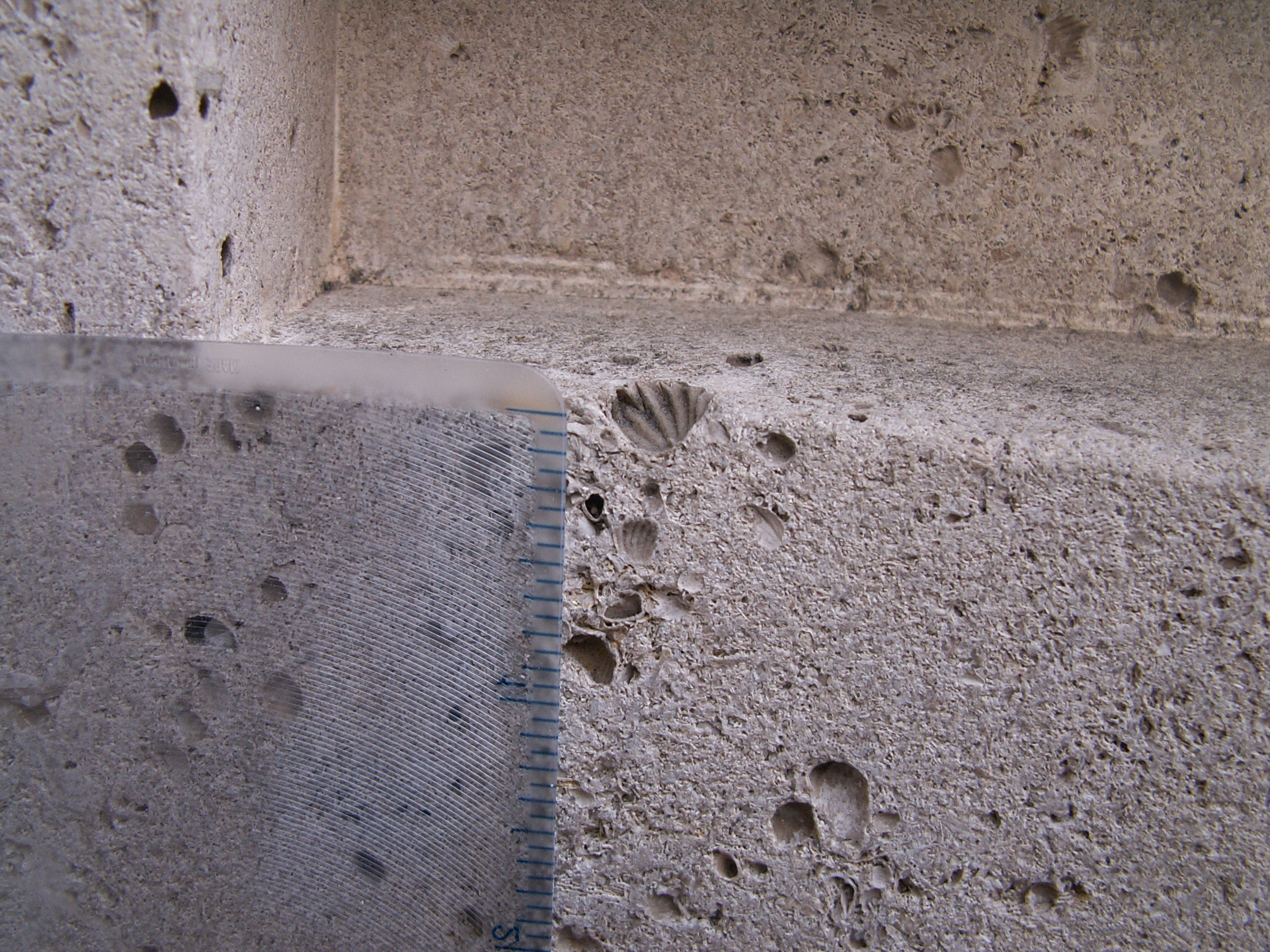

Gastropods. These are a class within Phylum Mollusca which includes modern snails and slugs. Gastropods have asymmetric bodies with a distinct head and foot, and usually a hard shell in the form of a tapering, coiled tube. The body design of a typical gastropod is shown below.

Source: Maryland Geological Survey E.S. No. 4, p. 30, Fig. 24.
Like modern snails, the Paleozoic gastropods displayed a wide range of shells. However, in the Salem Limestone, only the portion of the shell near the tip (apex) is easily recognizable. This is another look at the picture shown above for crinoid columnals. In this context, note the narrow gastropod shell, tall and tightly-spired, to the right of the ruler:
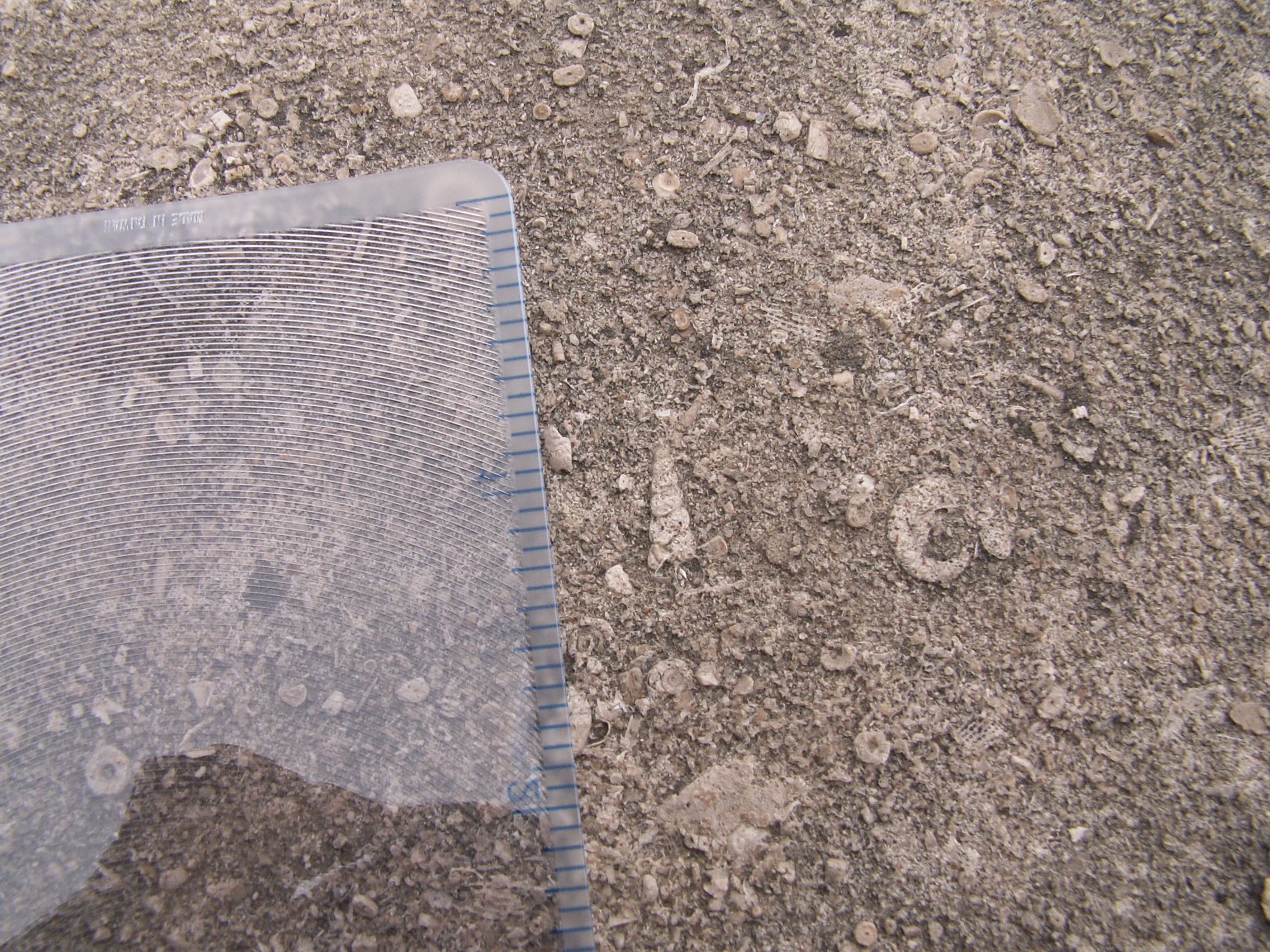
Trace fossils
The largest and most easily visible fossils of the Salem Formation are trace fossils (or, more technically, “ichnofossils”, from Gr. “ikhnos” meaning “track” or “trace”). Trace fossils are visible shapes in the stone that reflect the movements or passage of organisms in the soft sediments of the sea. Trace fossils typically reflect the activities and presence of bottom-dwelling and subsurface animals. They are a reminder that the rich diversity of that marine environment stretched below and above the submerged surface. Two reconstructions of the structures created by such organisms in the shoal region of the Salem Limestone appear below:
A 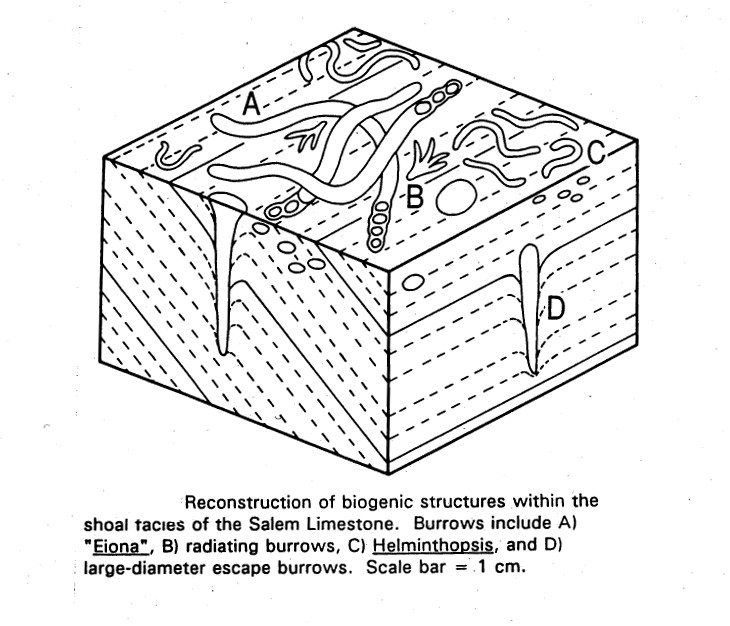
B 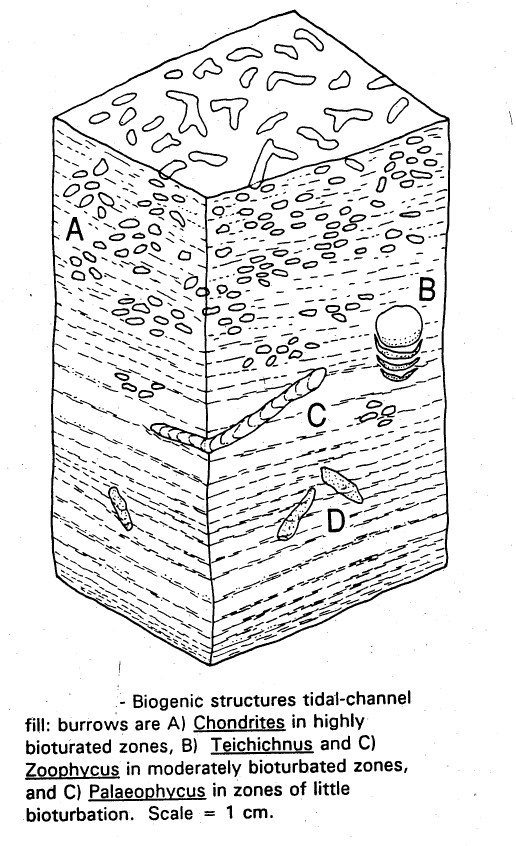
Sources: A, Indiana Geological Survey Guidebook 14, page 23, Fig. 15; B, Indiana Geological Survey Guidebook 14, page 25, fig. 17.
These reconstructions are the result of detailed research in the exposed faces of various quarries in the Salem Formation – few can be observed in the surfaces of building stones. However, structures similar in appearance to the “burrows” formed by the organism named Eiona in “Figure 17” appear to be visible many places the city. At the Lisner Auditorium, prominent burrows appear on the capstone on the north side of the front steps:
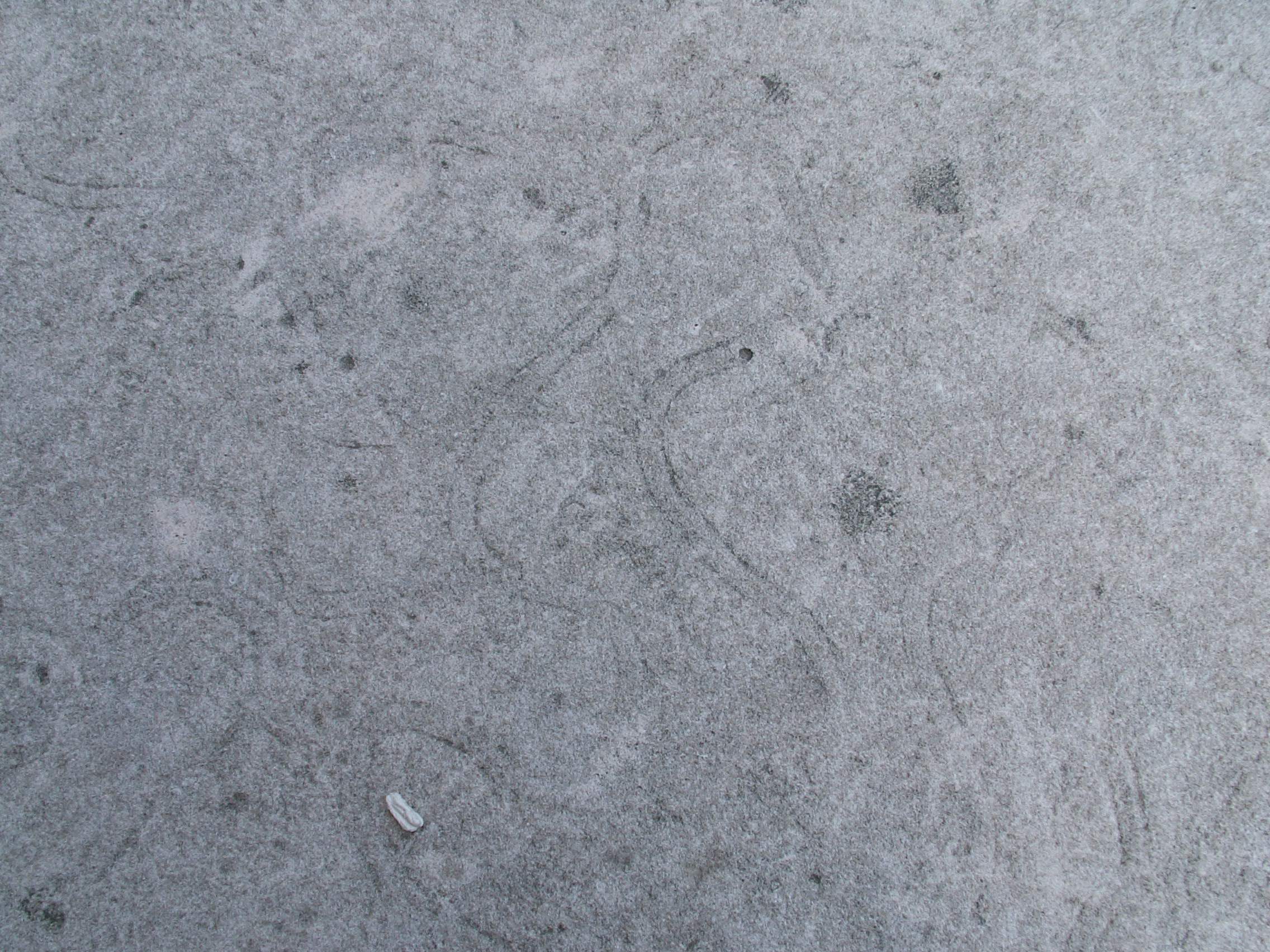
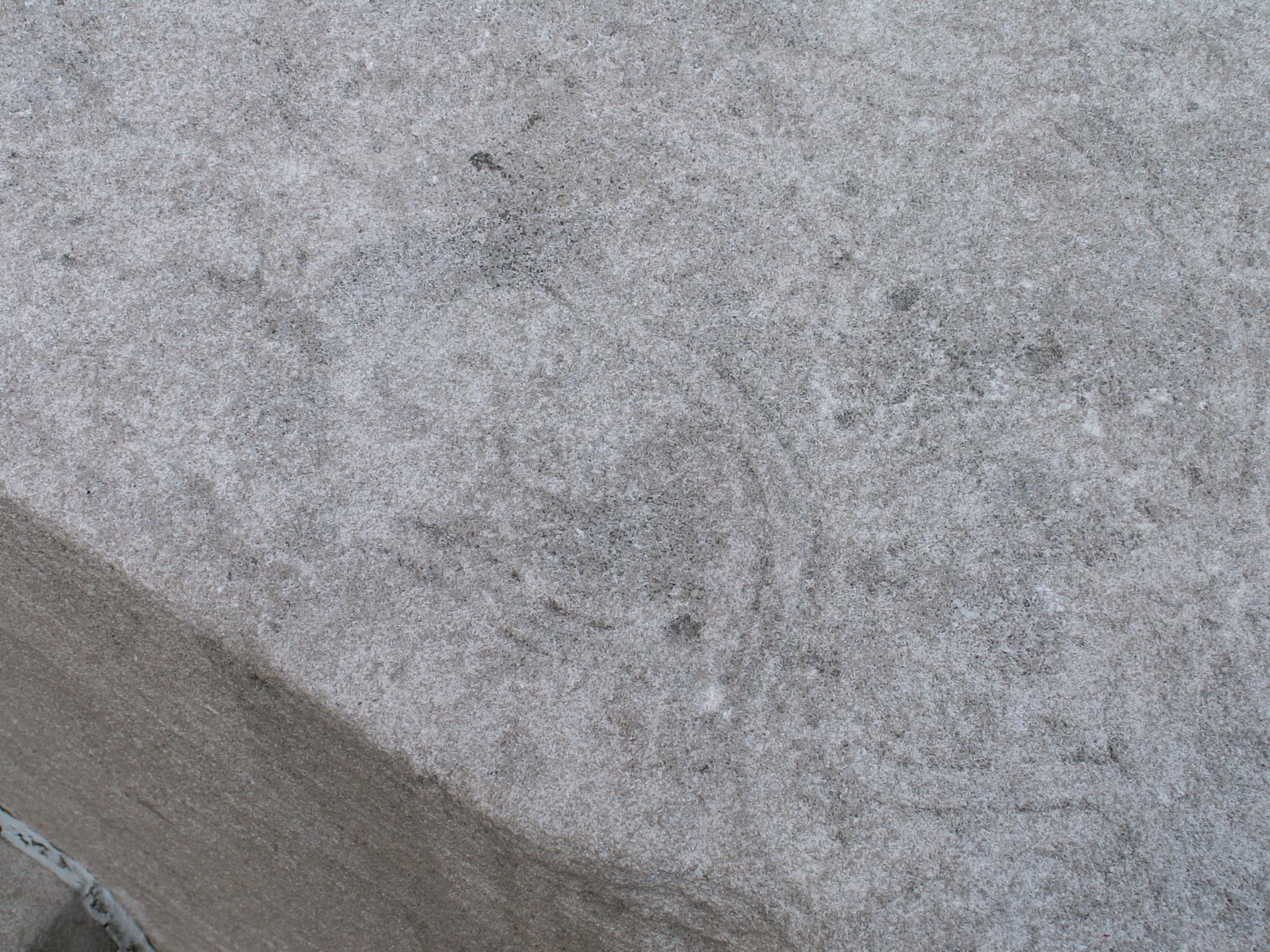
See also similar structures in the right and left of the side entrance facing H St., N.W.
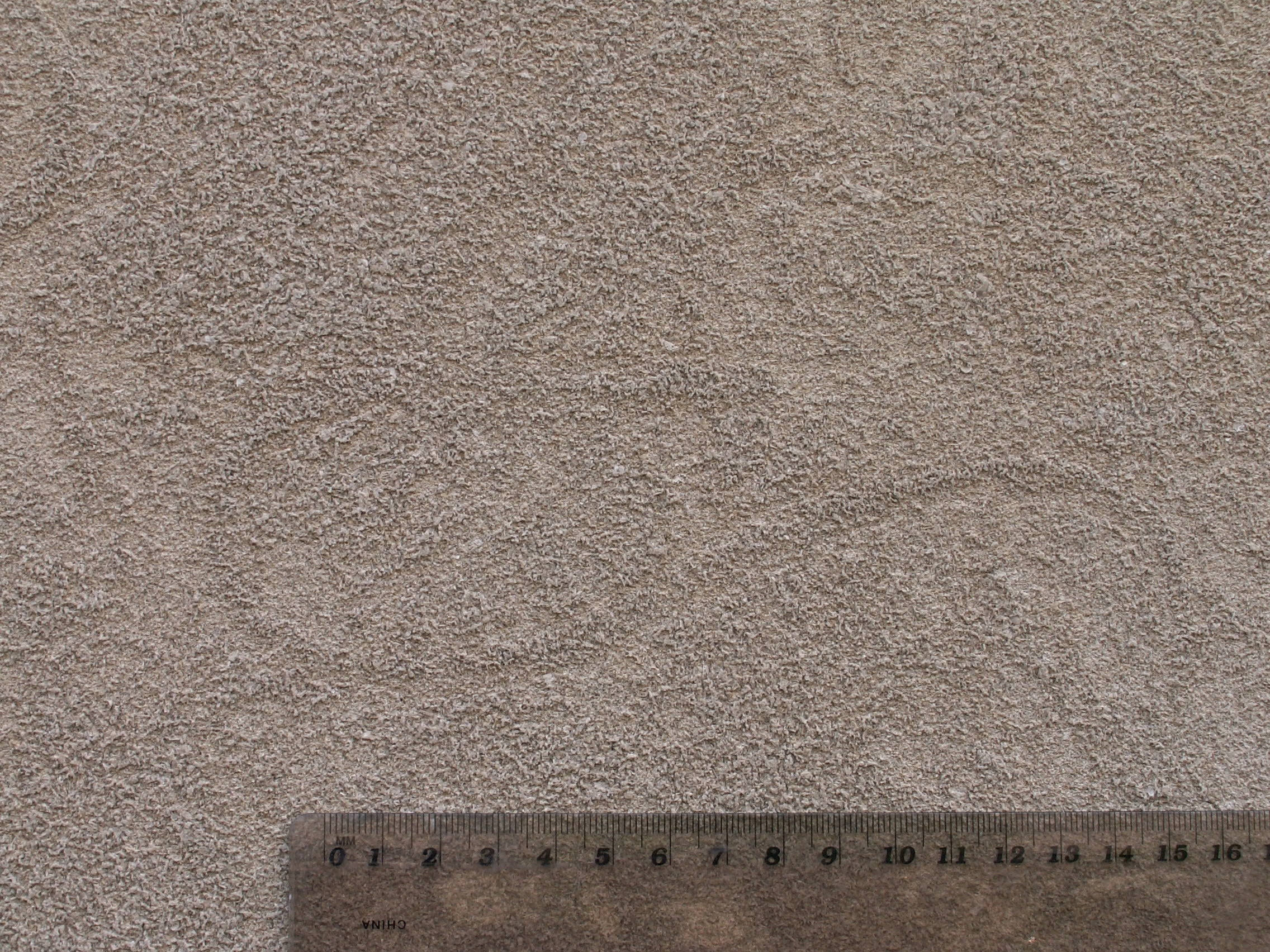

The burrows also appear in a pattern that resembles a necklace, as in the retaining wall of the Department of Labor Building, on 3rd St., N.W., between Constitution Ave. and C St.:
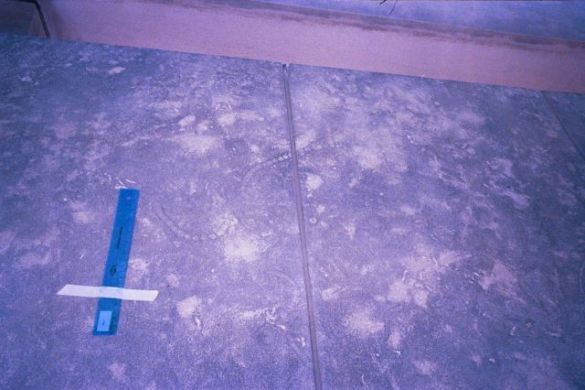
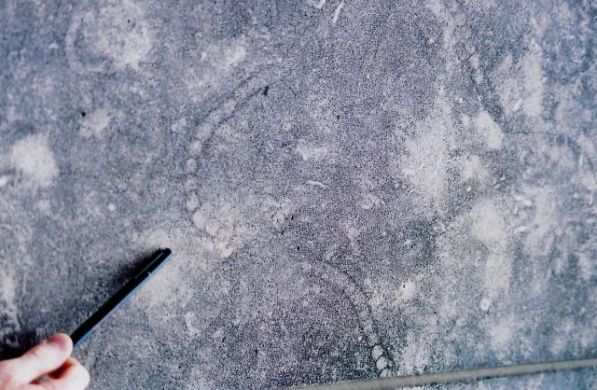
A large display of these trace fossils can be found on the stone balustrade overlooking the Tidal Basin, where 17th St. terminates at Independence Ave.:

Many similar trace fossils can be found around the city.
The Missing Organisms
The organisms that created these “burrows” are not well understood. Even the name noted above – Eiona – is somewhat misleading, to the extent that it suggests certainty. The study using this name notes that the name is used “somewhat informally,” because “the taxonomy of this form has been uncertain.” Stated more simply, despite extensive research devoted to the Salem Limestone, its sedimentary structures and animals, we do not know exactly what animal made these shapes. Currently, geologists think the source of these burrows was probably a soft-bodied worm. We do not know with certainty because the body tissue of the burrower left no fossil.
These uncertainties serve as a useful reminder about the incomplete nature of the fossil record. For all of its visible fossils, the Salem Limestone lacks remains of many organisms that made up the rich marine life of the Mississippian environment. The list of known animals of the Salem Formation – 187 species from many major phyla – is very impressive. It is, however, only a selective sample of the plants and animals that lived in that shallow sea. Absent from the limestone are visible remains of many soft-bodied animals like the burrow makers, many marine types of marine plants, and animals without hard calcareous skeletons or shells. The fossil record of any given location is nearly always highly selective. The presence of burrows without any remains of the burrow-makers is therefore not surprising, but typical. The burrows highlight the accident of geological circumstances that permit a wide variety of visible fossils today.
Reconstructing the Ancient Environment
Sedimentary structures in the stone
The Salem Limestone is composed largely of fossils, but its role as a window into the past goes well beyond the individual fossil types. The limestone also contains sedimentary structures that reflect environmental conditions at the time the sediments were deposited. For the observer of urban limestone, some of these sedimentary structures are fairly common, and three major categories are discussed below.
Ripple marks
Waves and water currents cut patterns in the soft sediments of the Mississippian sea. After additional sediments accumulated on the sea bottom, these patterns were often reflected in the shape of the sediments. When the limestone is cut horizontally (parallel to the plane of deposition) through a layer with ripple marks, the surface appears to be channeled and whorled. The builders who constructed the noted Art Deco front of the old D.C. Greyhound Station, at 1101 New York Ave., N.W., used what appears to have been standard Salem Limestone:

Indeed, the builders appear to have consciously chosen Salem Limestone surfaces displaying ripple marks:
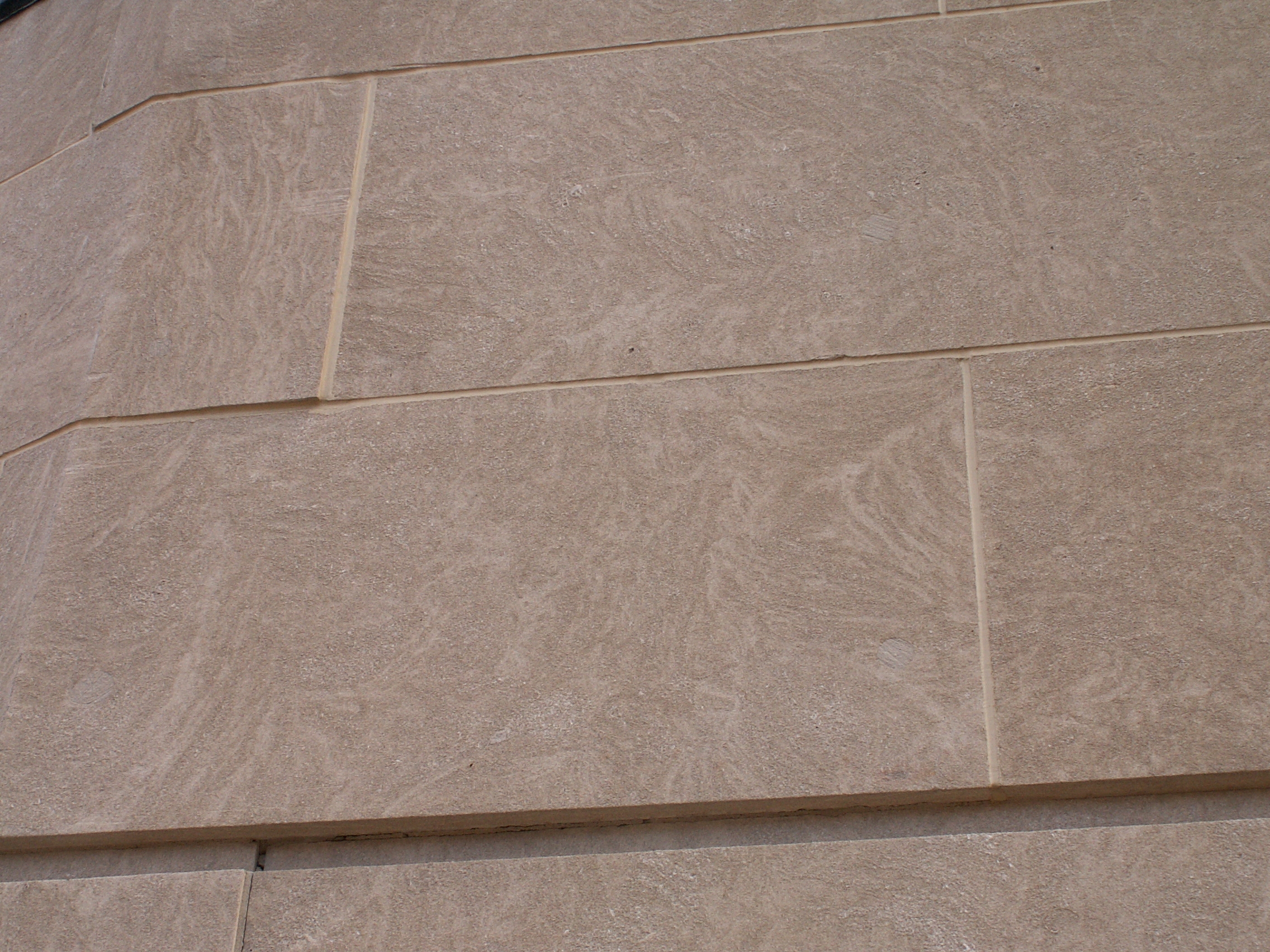
Other examples include the apparently intentional choice of all-ripple-marked Salem Limestone on the street face of 1700 14th St., N.W.:
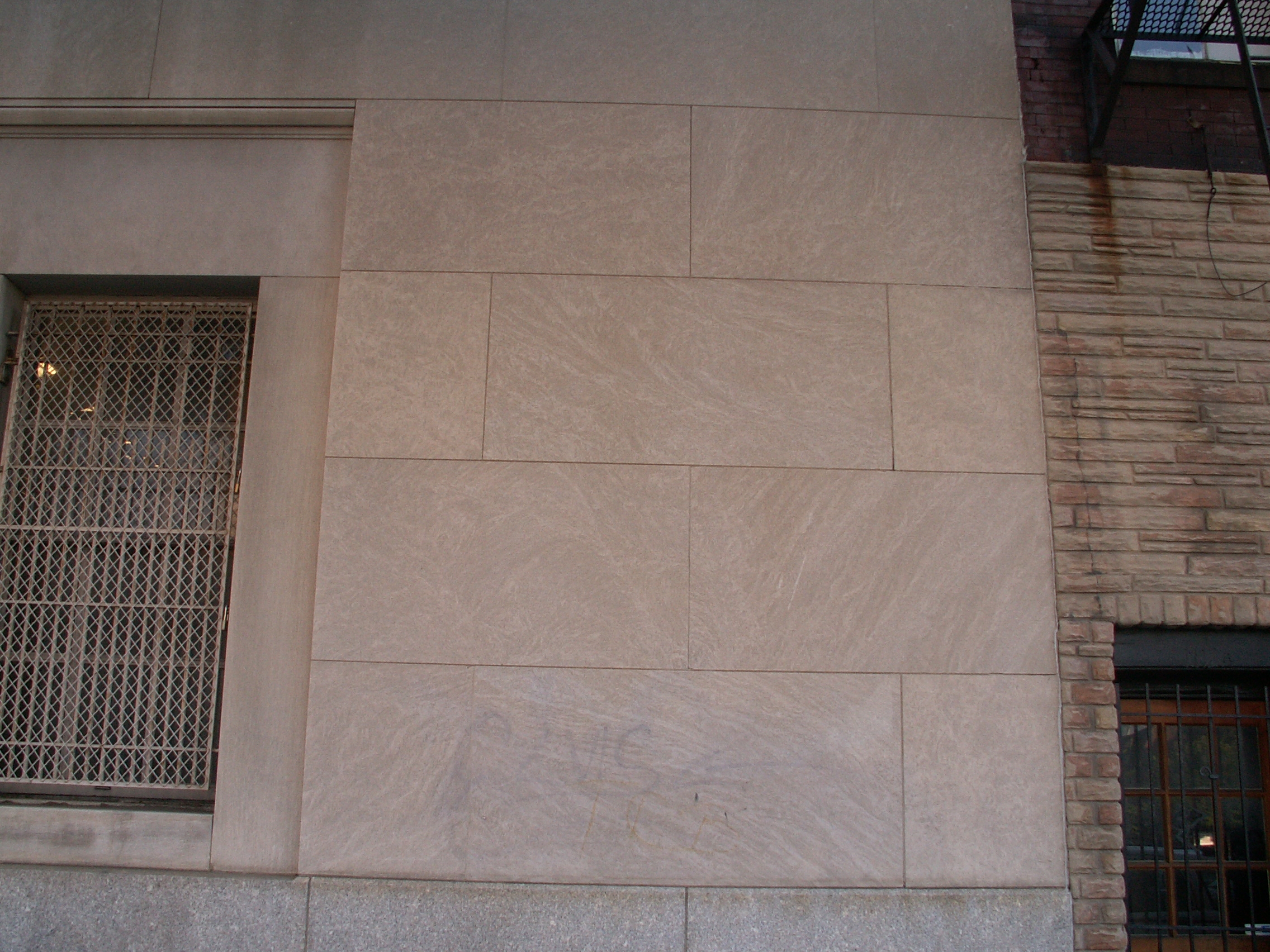
Ripple marks appear in many structures across the city. Anyone waiting in line to see a new blockbuster film at the Uptown Theater, 3426 Connecticut Ave., N.W., can step aside and see some ripple marks on the sides of that Art Deco structure.
The bedding lines represent changes in the depositional environment – sometimes very small changes. Each bedding plane contains slightly different sizes of calcium grains, and/or slightly different shades of buff or gray, and other differences that create a visible change from the beds above and below. Although the planes may often reflect years of deposition, researchers have studied sufficiently fine laminar deposits that allow them to document cycles of neap spring tides and their impact on the deposition of the sediments in channels between shoals in the ancient sea.
Cross-bedding
Geologists often describe the Salem limestone as being “thickly cross-bedded.” This type of feature is not always visible in buildings, because quarries often cut parallel to the bedding, to maximize the appearance of uniformity. One can see cross-bedding in many structures, however; this is one example:
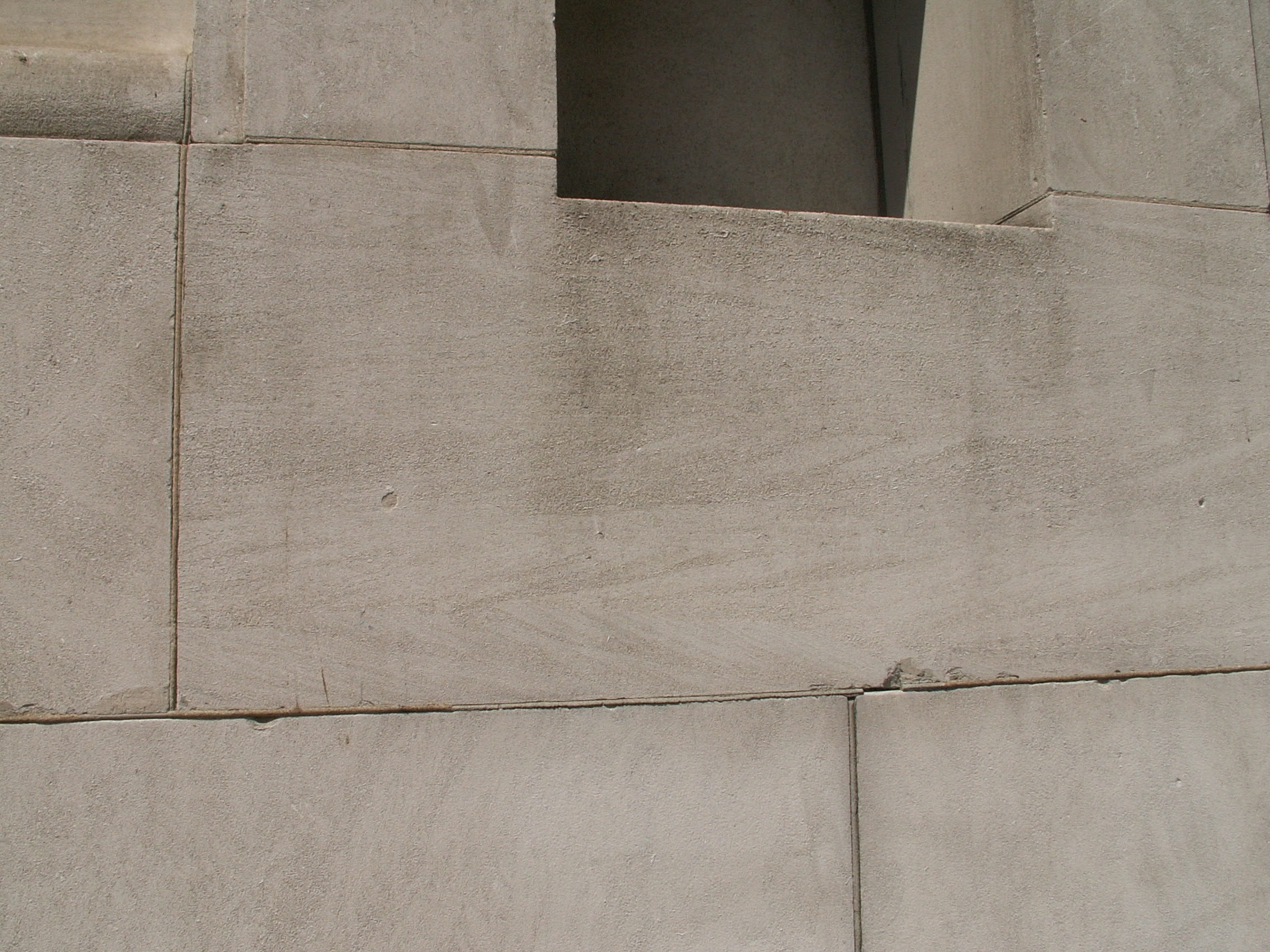
Look closely at the stone below the window, in NMWA No. 9. Note the presence near the bottom of many slanted, relatively short lines, or bands, alternately dark and light in color. The direction of the bottom layer of these beds is from upper left to lower right. Note further how the upper end of these slanted beds row of such slanted beds ends along a horizontal line. Immediately above that line appears another row of short, slanted bands, but these beds slant in a different direction: from lower left upward to upper right. Additional layers of slanted bands appear above, sometimes cut off and then overlain by a new set slanting in the same general direction.
This pattern reflects “trough cross bedding.” The slanted lines reflect a series of sedimentary beds deposited along the slope of a trough in the shoal bottom, formed by persistent currents. Over time, prevailing currents changed, the old trough was covered in newer sediments, and new troughs formed above the earlier ones. The new troughs would often slope in the opposite direction, forming the other side of a new trough. As sediments accumulated, different troughs and their varying slopes would form successively, one on top of the other.
In building stones, only isolated fragments of any trough system are typically visible. In the field – or, more specifically, in the Salem Limestone quarries – geologists have been able to study broad expanses of the formation, both horizontally and vertically. Detailed study has permitted the measurement of the direction of the paleocurrents that formed the troughs. Through hundreds of measurements, geologists have determined that virtually all of the current flow in these shoals was onshore in direction. An observer of the cross-bedding in NMWA No. 9 is therefore likely looking directly into the direction of either the onshore current driven by flood tides, or the ebb flow back. Not all cross-bedding reflects trough bedding; sometimes it resulted from the migration of dunes within the shoal system.
Other cross-bedding examples recur throughout the city, but illustrative examples can be found in the front of the office building at 722 12th St., N.W. and on the 18th St. side of the Order of the Eastern Star building, 1618 New Hampshire Ave. Many panels of cross-bedded limestone can be seen in the walls along the sidewalks on the Duke Ellington Bridge, where Calvert St. crosses Rock Creek Park. The casual observer to these structures cannot draw conclusions about the shoal environment, but can recognize in these structures the impacts of currents and tides 350 million years ago.
Using fossils and sedimentary structures to model the ancient environment
Geologists have been able to study a large number of points where the Salem Formation is exposed, at both man-made sites (quarries, roadcuts, sampling cores) and natural ones (valleys). We therefore have a detailed understanding of the different environments which created the Salem Formation – enough to permit detailed modeling of the ancient ecosystems and landscapes that formed the deposits. The modeling does not permit a map or literal reconstruction, but it does allow us to understand both the types of environments and how they related to each other. One such model appears below:
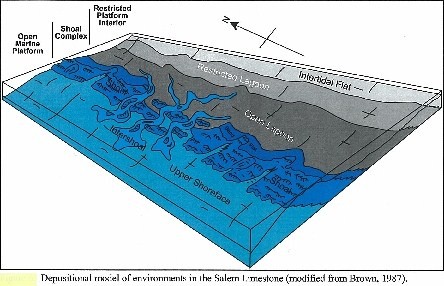
Source: Indiana Geological Survey Guidebook (unpublished).
The principal distinctive types of limestone, determined by the fossil assemblages (fauna) and physical characteristics (lithology), or “facies,” include the following:
- Shoal. (Almost all of the building stones are quarried from shoal areas, because of their thickness and the quality of the stone.)
- Intershoal.
- Open Lagoon
- Restricted Lagoon
Each of these facies differs from the others, based on the following features:
- the lithology, i.e., the “grain size” and color of the formation:
- the paleoecology, particularly the types of fossils, specifically,
- whether the principal organisms were active or stationary
- distribution and types of fossils (i.e., counting the genera of each major fossil type occurring in the facies)
- whether the fossils appear to have been transported or lived and died in place.
- presence, absence and types of trace fossils.
- the types of physical sedimentary structures, such as trough bedding, rippling, etc.
The detailed modeling allows researchers to understand the paleoenvironment better. For better or worse, only a limited sample of these facies appears in manmade structures: quarries typically chose to operate in shoal zones, largely because the beds are generally thicker and most uniform at those points. This depositional model illustrates where specific quarries of the Salem Limestone would have been located in the Mississippian environment:
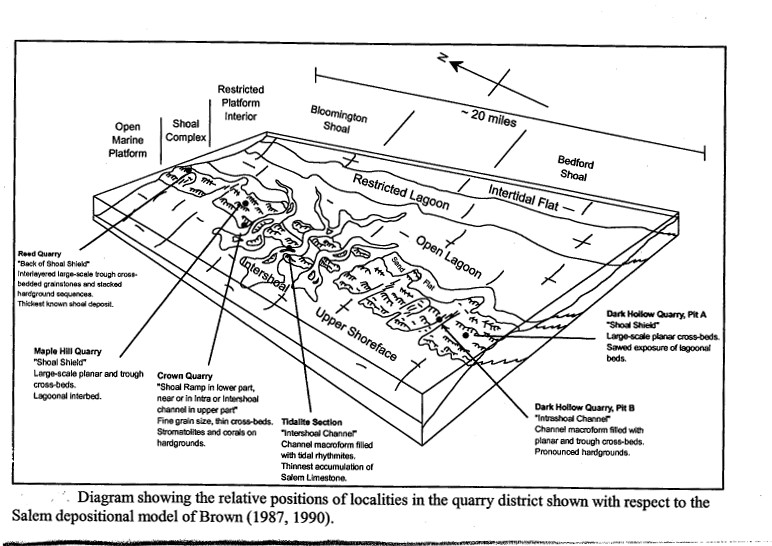
Source: Indiana Geological Survey (unpublished)
More broadly, the stone removed from the Salem formation reveals a consistent bias as to origin. The Salem formation is generally much coarser in its lower reaches than in the upper strata. Researchers believe that the energy level (waves and currents) was likely higher in the later periods, resulting in fossil debris in the higher regions that is finer due to more active sorting and abrasion, as well as more calcium-coated grains. Such conditions may have attracted different organisms, such as forams, which preferred such conditions. As a result, quarries and stone companies have tended to prefer taking stone from the upper Salem deposits, particularly for newer buildings. Older buildings, and in particular houses, often received the more rustic variety of Salem stone, displaying larger fossils, quarried from the older, lower portions of the formation.
About the Salem Formation
Location
The Salem Formation is composed of massive, thick beds of medium-grained bioclastic (skeletal) limestone. The formation outcrops near the surface in a narrow and irregular band, approximately 30 miles long and two miles wide, stretching from west central Indiana toward the Ohio River. Quarrying occurs even more narrowly in a zone roughly between and around Bloomington and Bedford, as the map below shows:

Source: Indiana Geologic Survey (unpublished).
Most rock strata underlying Indiana slope gently downward into the earth, slanting from northeast to southeast. Therefore, the Salem Formation stretches unseen and underground, far to the west and south of the surface outcrop in Indiana, well into Illinois and Kentucky, where it trends deeper and deeper underground and locally is a prominent petroleum reservoir. In the area of Indiana where the Salem rock stratum outcrops at the surface, the formation is generally between 60 and 100 feet thick.
Deposition
The formation resulted from the deposition of calcium-rich sediments over several million years. It formed at the bottom of a warm, shallow inland sea, approximately 350 million years ago, during the Mississippian period. Below is a paleographic map of the area that is now the United States, during the general time period for the Salem Formation, indicating that the paleoequator ran only slightly north of modern day Indiana:

Source: Indiana Geological Survey Guidebook No. 16.
Conditions created a rich ecosystem in which animals with shells were numerous; they lived, died, and their hard, calcareous skeletal remains became built up in ever-deeper layers. It was a high-energy environment. In numerous shoals strong and persistent currents broke up the shells, transported them (though not generally far), and abraded and sorted them into a kind of calcite-based sand. Many shell fragments eventually became coated in calcite precipitated from the water, giving them a rounded indistinct appearance. The sediments formed by this once-living sand were almost pure calcium carbonate.
Burial, lithification, uplift and exposure
The Salem Formation had been deposited over earlier marine sediments that reflected a slightly different environment, the Harrodsburg Limestone. In turn, the sediments of the Salem Formation were covered by the slightly different calcareous sediments that would later become the St. Louis Limestone. During the Mississippian period of Indiana, almost thirty distinct formations can be found:

Source: the Indiana Geological Survey website, “General Stratigraphic Column for Paleozoic Rocks in Indiana.
Over time, the continental mass was depressed in this area, as the Illinois Basin formed and thousands of feet of additional sediments were deposited on top of the Salem sediments, throughout the Pennsylvanian period, ending 280 million years ago. Under the weight and pressure of the overlaying strata, the sediments of the formation compressed, fluids mostly water) were expelled and carbonate minerals formed a cement in the pores between the oolites and skeletal remains. The result, millions of years later, was hard limestone rock. Geologic forces then uplifted Salem Formation above sea level. Since then the principal forces have been erosion. More than 1,000 feet of bedrock located above the Salem Formation eroded away over time. That process culminated in accelerated erosion from the outwash of the glaciation occurring within the last two million years. As a result, outcrops of the Salem Formation appeared in surface and river valley outcrops during historical time.
Identifying Different Types of Salem Limestone
The Salem Limestone has several different grades, which can significantly differ in appearance. Several major types are:
Select, Gray or Buff (tan) Fine to average grained stone with a minimum of features such as large fossils, calcite veins, large pores, etc.:
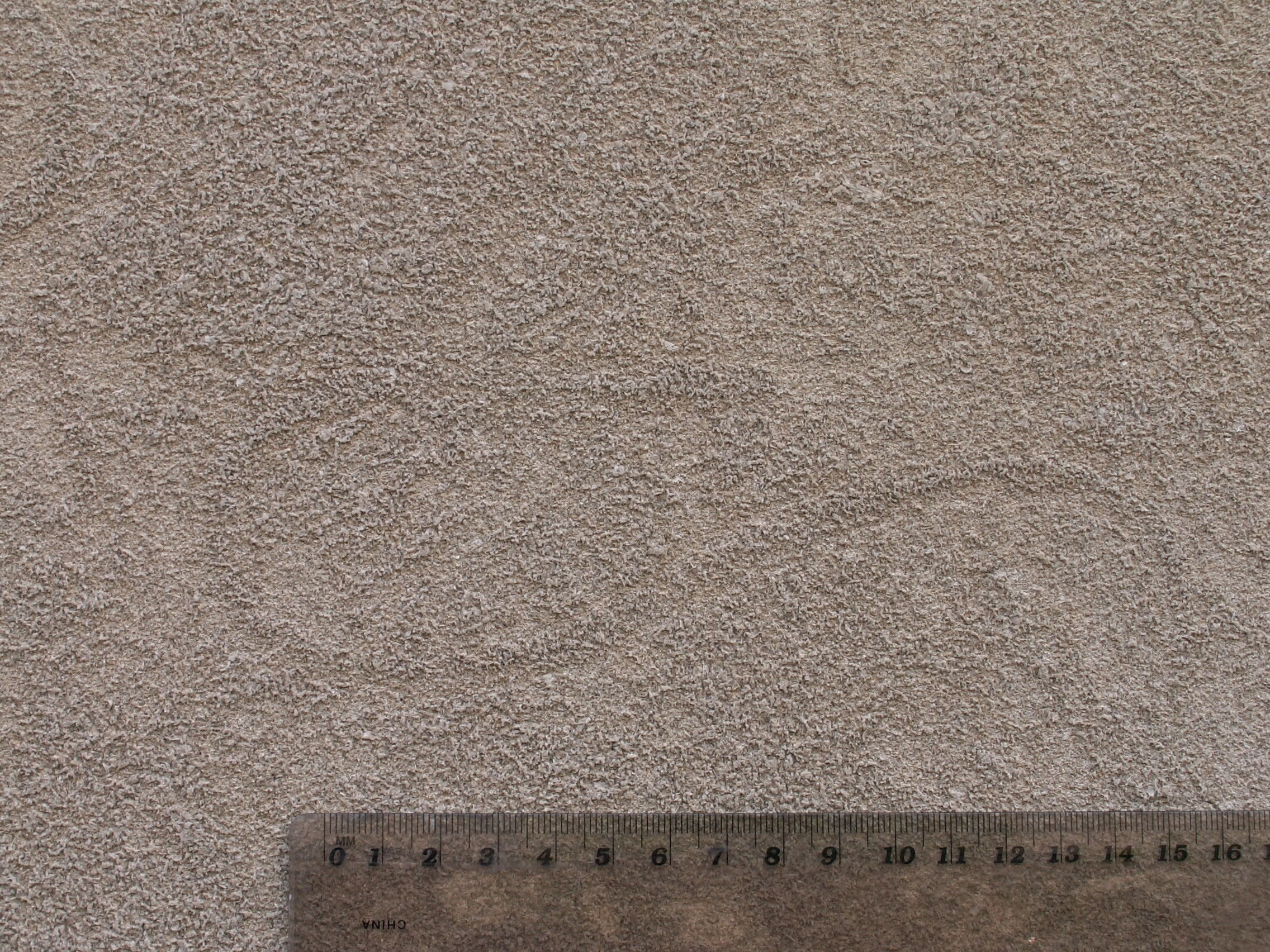
Standard – fine to moderately large grained stone with an average amount of features noted above. The pictures above of the limestone at the National Museum of Women in the Arts appear to be “Standard.”
Rustic – fine to very coarse-grained stone permitting an above average amount of the features noted above, as shown by the surface of 601 Pennsylvania Ave., N.W.:

The “holes” in the stone above are molds left by sizeable fossils.
Variegated – an unselected mixture of the three grades above permitting
both buff and gray colors, is illustrated by the contrasting shades of the limestone panels on the exterior of 1001 Pennsylvania Ave., N.W.:
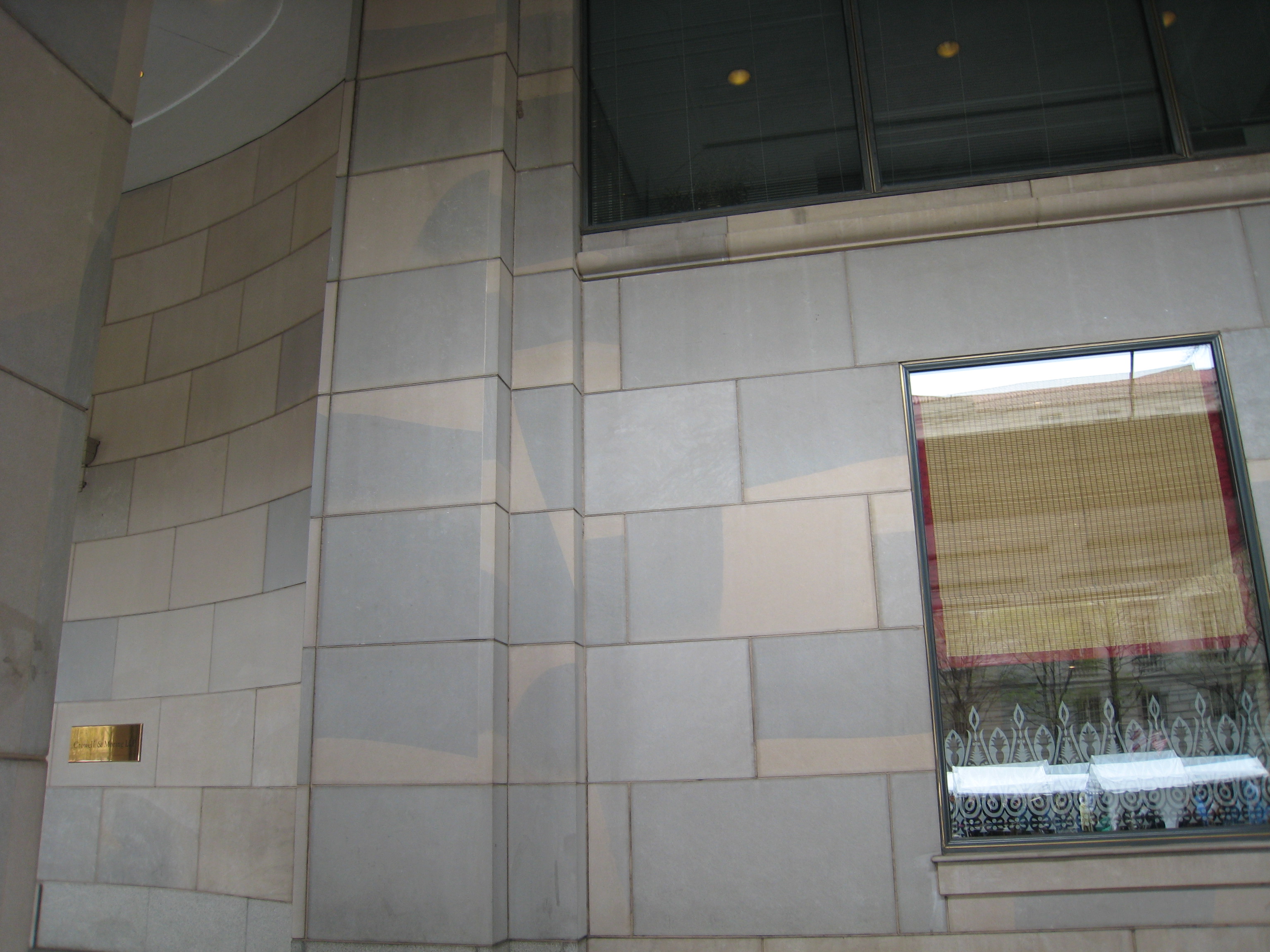
Variegated limestone is very common in and near the Federal Triangle, the downtown area bordered by Constitution Ave., Pennsylvania Ave. and 15th St., N.W.
“Gothic” (rare in D.C.) Stone stained with dark red iron excrescence, as shown in the walls of 1715 15th St., N.W.:
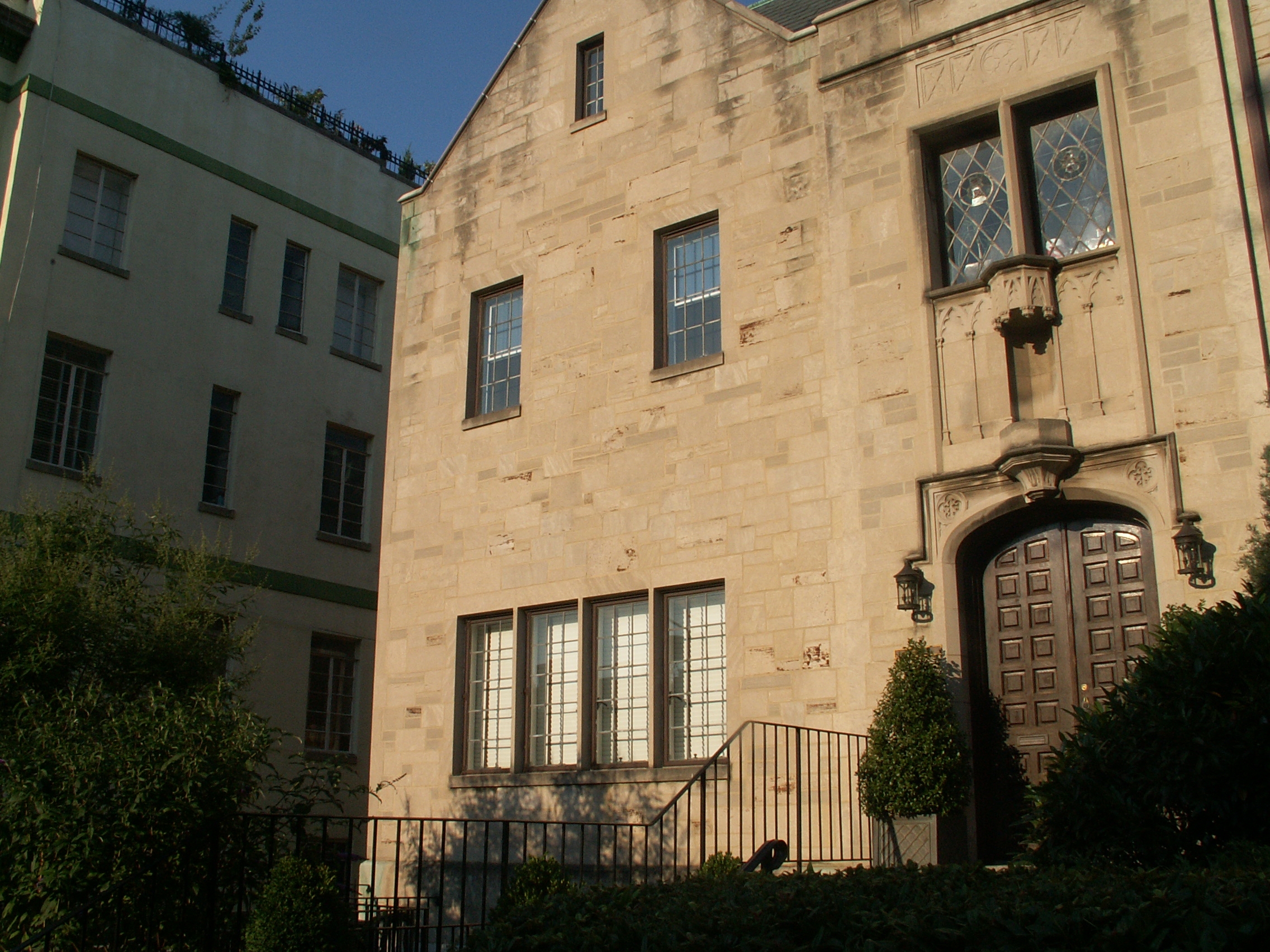
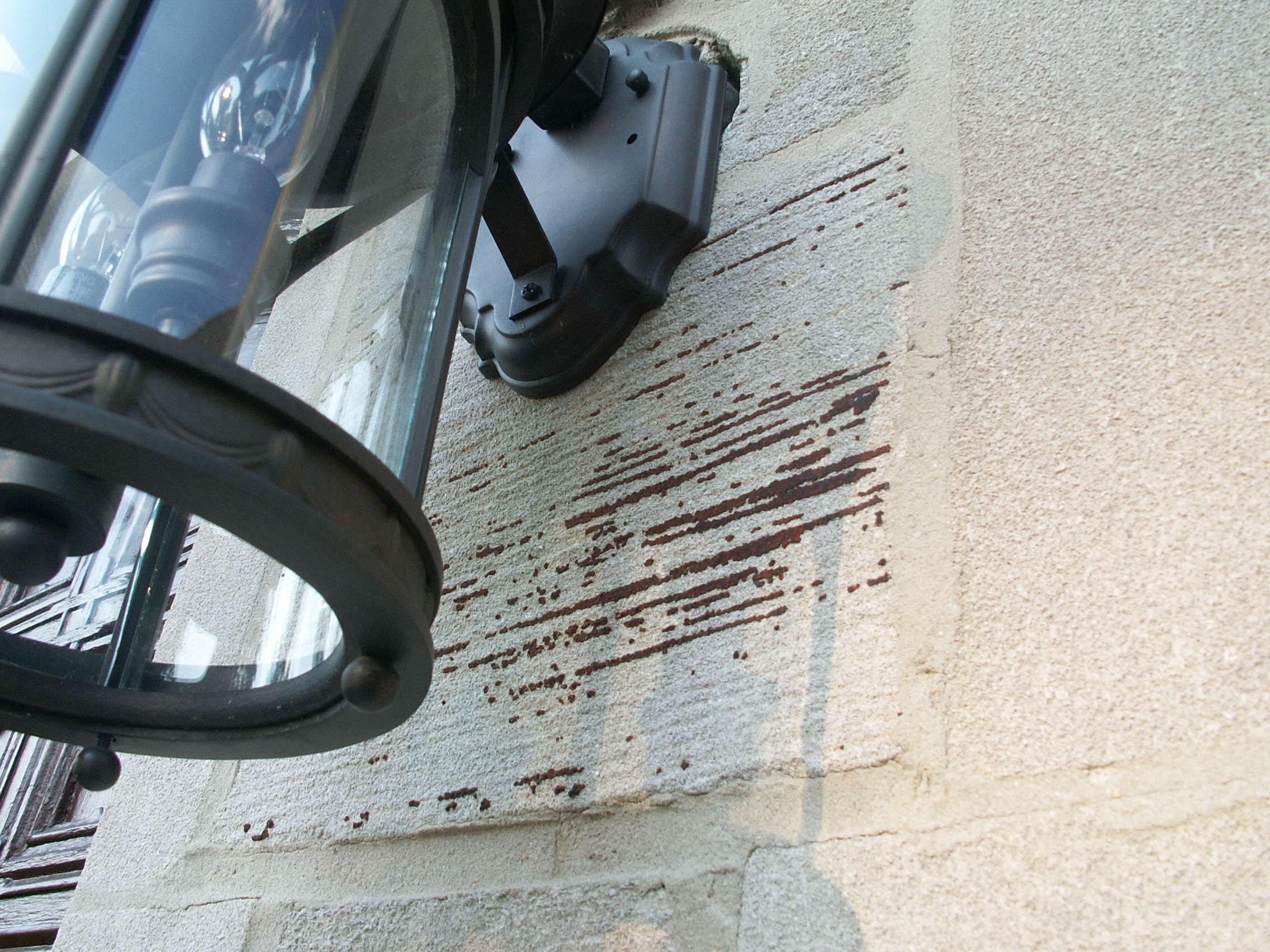

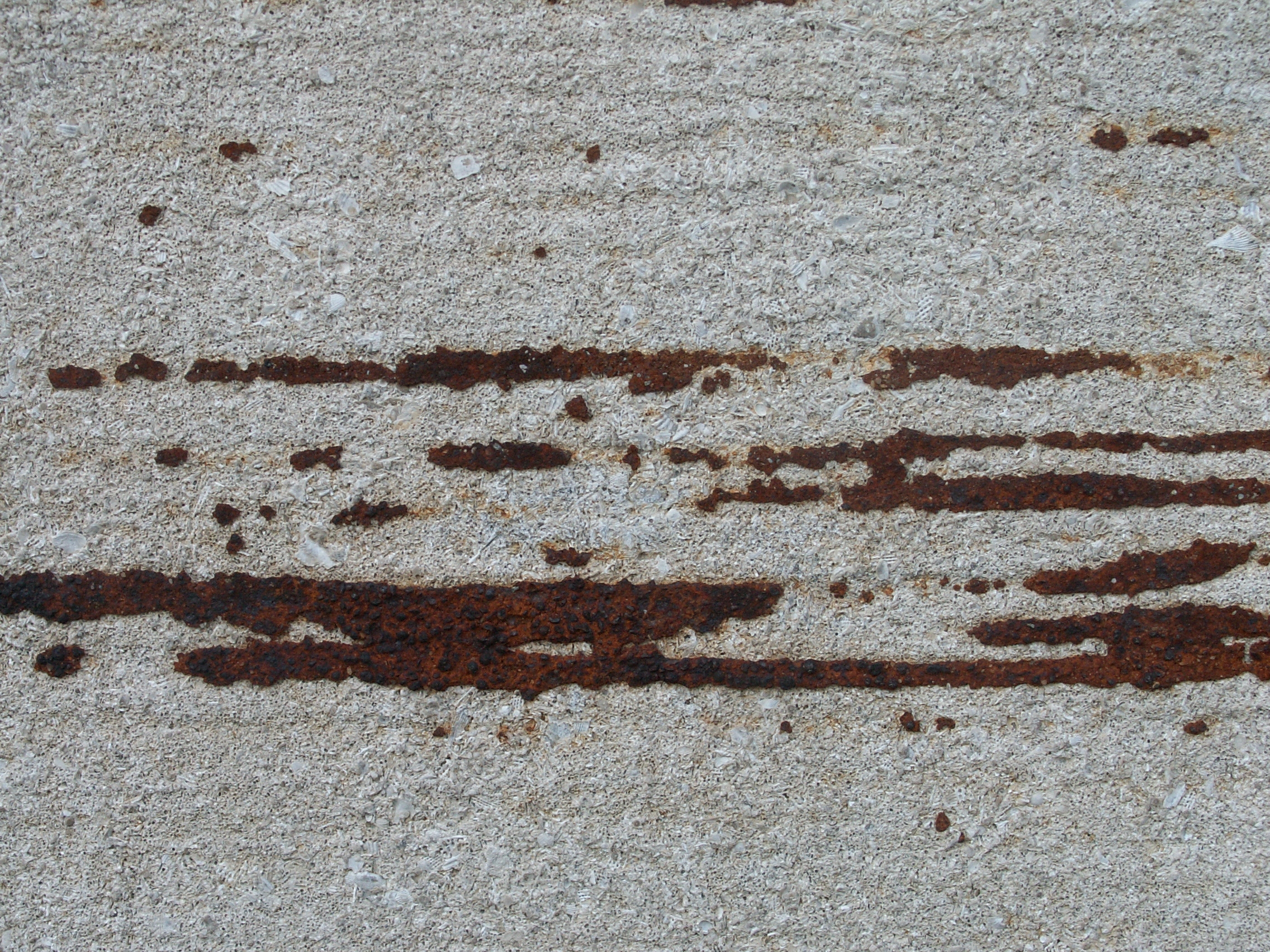
Why do the colors differ in Salem Limestone?
Grey is the natural color of the Salem Formation. Groundwater moving through fractures changes the gray to buff due to oxidation of trace amounts of organic matter and iron in the stone. This water exposure does not change the strength or other characteristics of the stone aside from color. The buff color forms a halo around the fractures and the width of the halo can vary widely — possibly related to minute differences in permeability that are often not visibly obvious. Generally, quarries on the sides of valleys or drainages will have more buff stone that will decrease as they mine back into the hillside.
The “gothic” stone shown above, with black and dark red/black stains, is an entirely man-made phenomenon. The quarries would leave saws embedded in the stone, wet, to impart the bands of oxidized metal that give the stone its distinctive appearance. Gothic stone is no longer being produced.
Why Salem Limestone Pervades the City
Salem Limestone is the dominant limestone found in Washington architecture. Although often associated with great public buildings, the Salem Limestone is also common in humbler structures, particularly those constructed in the 20th century. A few historical statistics illustrate its persistent popularity:
- In 1900, Indiana Limestone provided 30% of the value of total limestone sales for construction in the U.S.
- In 1920, that figure had risen to more than 80%.
- In 2000, Indiana still accounted for more than 53% of all U.S. limestone production.
Those figures are national in scope, but the Indiana Limestone industry has regarded Washington as one of its principal markets for well over a century.
Many other domestic types of limestone are marketed in the U.S. What accounts for this long predominance?
Like many types of limestone, the Salem Formation was first quarried and used locally — in 1827. Rail transportation became available in the 1850s as major railroads were built directly through the three-count area where the Salem Limestone is extracted, which permitted its export to other domestic markets. Major fires in Chicago and Boston in the 1870s provided Indiana Limestone major showcases for its ability to withstand fire and its value in the rebuilding that ensued. By the late 1880s, Indiana Limestone had become popular throughout the Midwest and East Coast. The widespread choice of Indiana Limestone over other domestic types of limestone had many causes:
- Abundance. It is massively abundant; unlike many formations, which have been quarried out or offered only limited access. At its height in 1929, more than 12 million cubic feet of Indiana Limestone was quarried – more than four times the total amount of limestone quarried for dimension stone sold annually in the entire U.S. today. There is enough accessible Indiana Limestone even now for hundreds of years of production at current rates.
- Price. It has been economical to extract, economical to mill, and even economical to ship –benefiting in earlier decades from favorable railroad rates, which were designed to promote the transportation of Indiana Limestone to East Coast destinations.
- Physical characteristics. It is durable, strong and is a “freestone.” Freestones do not display a preferential direction of splitting and thus can be cut in any direction without losing strength due to the grain. Freestones can also be carved easily into sculpture.
- Color and texture. Light-colored grey and buff stone types have remained popular, and it is widely known as a fine or medium-grained, uniform-appearing stone.
- Architectural taste. The Romanesque Style of the very late 1800s favored use of the Salem stone. Subsequently, it was suitable for the very different demands of dimension stone cladding for the skyscraper era, and was adopted readily for Art Deco buildings. Throughout the late nineteenth and early-to-mid twentieth centuries, the color and look of limestone were held in high regard for many types of buildings.
- Fire resistance. After the big urban fires of the 1870s, ability to withstand fire was a factor.
And, last, but not least appropriate for Washington, D.C.:
- Politics. The Indiana representatives in Congress lobbied successfully for the use of limestone in federal buildings, particularly in preference to granite, which was used for a number of major federal buildings prior to World War I.
Indiana Limestone continues to appear in many new D.C. buildings, although the increased use of other U.S. limestones, imported limestones, and, especially, improved man-made cast stone products, has reduced its role from the heights reached in the mid-20th century.
However, given the number and prominence of buildings constructed in D.C. during the zenith of Indiana Limestone as a building stone (late 1880s through 1960s), it is and will remain, by far, the most prominent limestone on display in the nation’s capital – and the most immense and far-flung fossil display in the Accidental Museum.
Finding Salem Limestone at Home and in the Neighborhood
The Salem Limestone remains the only fossil-bearing stone that is consistently visible across the city. Indeed, unlike most other fossils, those of the Salem Limestone can even be seen in many homes. Houses built in the very late nineteenth century and the first six decades of the twentieth century, often have limestone elements, which in turn are often Salem Limestone. For example, older houses will have limestone in:
Door sills:

Window sills:

… and even capstones on top of brick steps leading up to front porches:

Apartment houses, particularly those built between the late 1800s and the mid-1900s, will similarly employ limestone sills, limestone lintels, limestone frames around entrances, and limestone trim at corners and along horizontal lines:
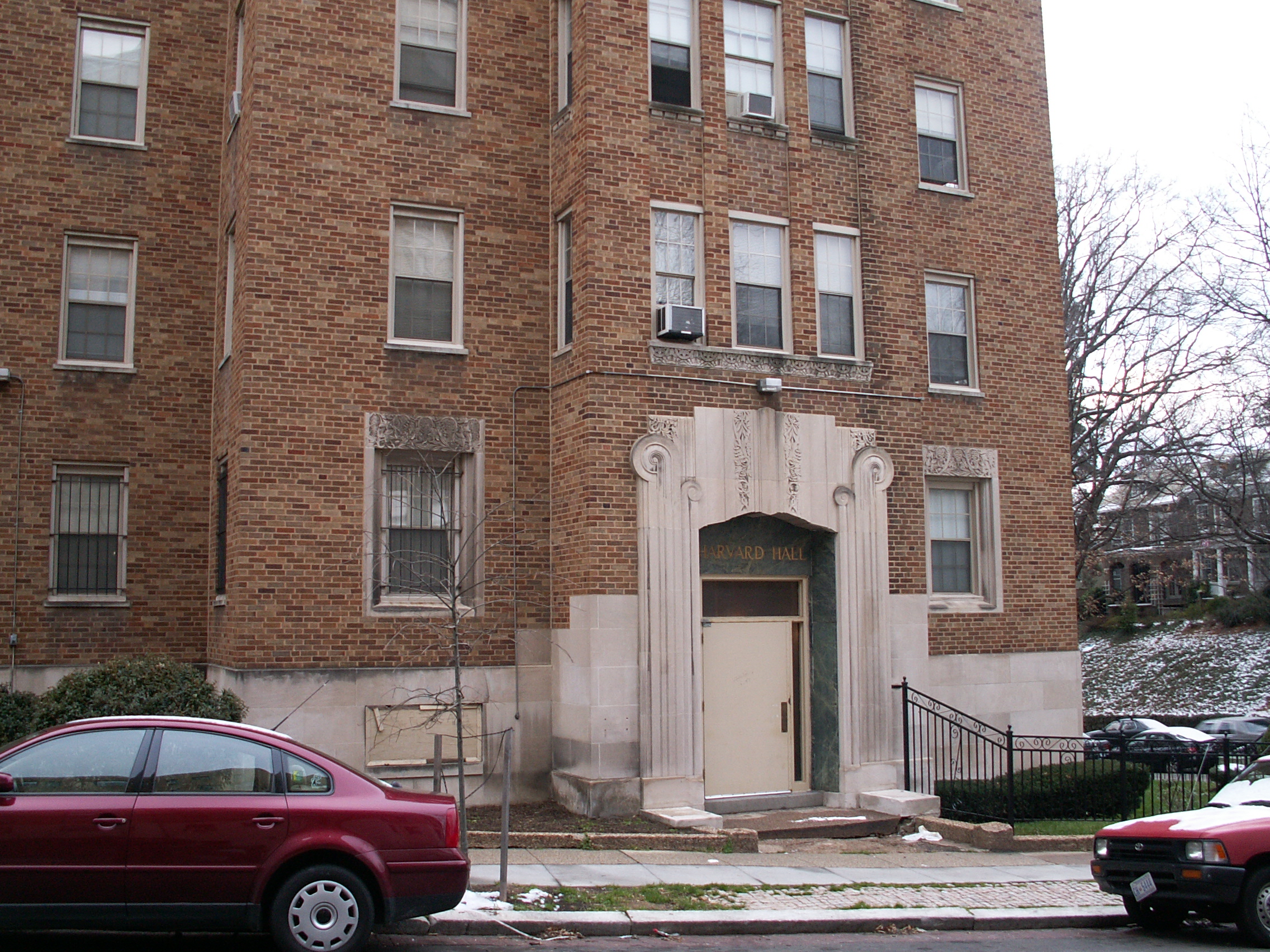
Newer houses and apartment buildings often lack these features. Even these structures, are not without fossils in some form. Most modern buildings use cement and concrete, which in turn is made with crushed limestone. Because most limestone is biologically formed, a basement floor or parking garage even in a very modern building very likely incorporates the fossil remains of ancient animals.)
Acknowledgments and Sources[1]
Special thanks in particular to Brian D. Keith, of the Indiana Geological Survey, for providing extensive resources on the Salem Limestone, as well as for reviewing photographs, text and answering many questions about the geology of the formation.
Thanks also to Jim Owen of the Indiana Limestone Institute, for sharing information and publications on the industry and its history.
Identification of the stone, fossils and formation. The United States Geological Survey’s Building Stones of Our Nation’s Capital discusses numerous occurrences of Indiana Limestone, as does the O’Connor Memorial Geological Tour and other D.C. sources quoting the late Prof. O’Connor. Some buildings have been identified by the Council on Fine Arts, which has architectural records on many buildings; some are named in other sources, such as the Women in Mining website, and personal communications from stone suppliers and architects (Lee Becker and Bill Lazar) and from Jason Kenworthy, National Park Service, who has studied the geology resources of the National Capital Parks – Central. The statement that hundreds of buildings in the District incorporate Salem Limestone is easily borne out by noting its characteristic appearance throughout town. The author counted a sample of nearly one hundred such buildings on two different routes between Mount Pleasant and the Old Post Office Building at Federal Triangle.
Information on the history of the Indiana Limestone industry, including factors in its growth: A Short History of Indiana Limestone, by William H. MacDonald (Lawrence County Tourism Commission, 1995); also general background information from the useful pamphlet, Indiana Limestone: A Premier Building Stone, by John R. Hill and Jim Owens, Indiana Limestone Institute and Indiana Geological Survey, Indiana University.
About the fauna, formation and paleoenvironment:
Cummings, E.R., J.W. Beede, E.B. Branson and L. McCartan, 1906 “The Fauna of the Salem Limestone of Indiana,” in the 30th Annual Report of the Department of Geology and Natural Resources of Indiana, 1905, W.P. Burford, pp. 1187-1486.
Architectural Elements and Paleoecology of Carbonate Shoal and Intershoal Deposits in the Salem Limestone (Mississippian) in South-Central Indiana, (ed.) Todd A. Thompson, Indiana Department of Natural Resources Geological Survey Guidebook 14 (1990).
Salem Limestone, Sanders Group, Mississippian System, Indiana Geological Survey website, http://igs.indiana.edu/geology/structure/compendium/html/comp3mzo.cfm
Indiana Limestone, by John R. Hill, Indiana Geological Survey Website, http://igs.indiana.edu/geology/minRes/indianaLimestone/index.cfm
Salem limestone occurrences and characteristics in the National Parks in Washington, D.C. – Personal Communication, Jason Kenworthy, National Park Service, 2004.
[1] Where this website cites specific internet page addresses, they are typically the addresses used by the author in researching and writing this discussion – a process taking several years. Unfortunately, in the meantime a number of the specific addresses have changed, and will continue to change, rendering some of these addresses ineffective as links. Readers should be able to find the material by searching for the proper name of the cited article or material on a search engine.
